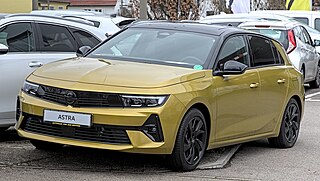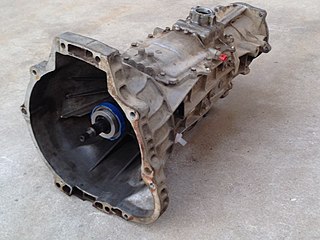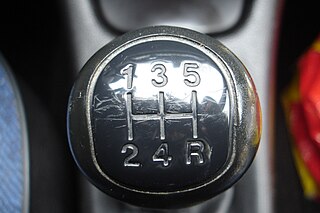
An automatic transmission is a multi-speed transmission used in motor vehicles that does not require any input from the driver to change forward gears under normal driving conditions. Vehicles with internal combustion engines, unlike electric vehicles, require the engine to operate in a narrow range of rates of rotation, requiring a gearbox, operated manually or automatically, to drive the wheels over a wide range of speeds.

The Opel Astra is a compact car/small family car (C-segment) developed and produced by the German automaker Opel since 1991, currently at its sixth generation. It was first launched in September 1991 as a direct replacement to the Opel Kadett. As of 2021, the car slots between the smaller Corsa supermini and the larger Insignia large family car.

A transmission is a mechanical device which uses a gear set—two or more gears working together—to change the speed, direction of rotation, or torque multiplication/reduction in a machine.

A manual transmission (MT), also known as manual gearbox, standard transmission, or stick shift, is a multi-speed motor vehicle transmission system where gear changes require the driver to manually select the gears by operating a gear stick and clutch.
A semi-automatic transmission is a multiple-speed transmission where part of its operation is automated, but the driver's input is still required to launch the vehicle from a standstill and to manually change gears. Semi-automatic transmissions were almost exclusively used in motorcycles and are based on conventional manual transmissions or sequential manual transmissions, but use an automatic clutch system. But some semi-automatic transmissions have also been based on standard hydraulic automatic transmissions with torque converters and planetary gearsets.
The modern usage of the automotive term manumatic denotes an automatic transmission that allows the driver to select a specific gear, typically using paddle-shifters, steering wheel-mounted push-buttons, or "+" and "-" controls on the gear selector.

The Opel Meriva is a car manufactured and marketed by the German automaker Opel on its Corsa platform, from May 2003 until June 2017 across two generations. Described as a mini MPV, it was marketed as the Vauxhall Meriva in the United Kingdom, while in Latin America, the first generation model was marketed as the Chevrolet Meriva.

A direct-shift gearbox is an electronically controlled, dual-clutch, multiple-shaft, automatic gearbox, in either a transaxle or traditional transmission layout, with automated clutch operation, and with fully-automatic or semi-manual gear selection. The first dual-clutch transmissions were derived from Porsche in-house development for the Porsche 962 in the 1980s.

Multitronic is a stepless transmission launched by AUDI AG in late 1999, jointly developed and manufactured by LuK. The capitalization used is multitronic and is a registered trademark of AUDI AG.

The automated manual transmission (AMT) is a type of transmission for motor vehicles. It is essentially a conventional manual transmission equipped with automatic actuation to operate the clutch and/or shift gears.

A gear stick, gear lever, gearshift or shifter, more formally known as a transmission lever, is a metal lever attached to the transmission of an automobile. The term gear stick mostly refers to the shift lever of a manual transmission, while in an automatic transmission, a similar lever is known as a gear selector. A gear stick will normally be used to change gear whilst depressing the clutch pedal with the left foot to disengage the engine from the drivetrain and wheels. Automatic transmission vehicles, including hydraulic automatic transmissions, automated manual and older semi-automatic transmissions, like VW Autostick, and those with continuously variable transmissions, do not require a physical clutch pedal.
Shift time refers to the time interval between gear changes in a transmission. This interval is the time in which power delivery is transferred to the next selected gear, and engine speed is reduced or increased to synchronize the speed of the next gear. Shift time is usually in reference to motor vehicles, but can apply to any gearbox. Shift time is measured by the time it takes for the engine rpm to synchronize with the next gear input speed target. This is illustrated by ZF, describing the 100-300 millisecond shifts of their DCT transmissions.

A sequential manual transmission, also known as a sequential gearbox or sequential transmission, is a type of non-synchronous manual transmission used mostly in motorcycles and racing cars. It produces faster shift times than traditional synchronized manual transmissions, and restricts the driver to selecting either the next or previous gear, in a successive order.

The Maserati GranTurismo and GranCabrio are a series of grand tourers produced by the Italian manufacturer Maserati, succeeding the Maserati Coupé and Spyder.

Selespeed is the name of an automated manual transmission used in Alfa Romeo cars, developed by Italian company Magneti Marelli and made by Graziano Trasmissioni.

Twin Clutch SST is the brand name of a six-speed dual-clutch automatic transmission, developed by Getrag for Mitsubishi Motors. The system was first incorporated in the 2008 Lancer Evolution X, and was designed to be a more performance-oriented system than that developed by rival manufacturers, with shorter gear ratios optimized for acceleration.
A MultiMode manual transmission is a type of automated manual transmission offered by Toyota. It uses a traditional manual gearbox with a computer-controlled clutch actuated by permanent magnet motors. Multimode Manual Transmission is available in the Aygo, Yaris, Corolla, Corolla Verso, Mark X and Auris in Europe, and should not be confused with Multimode Automatic Transmission, which is offered in the North American market by Toyota.

A dual-clutch transmission (DCT) is a type of multi-speed vehicle transmission system, that uses two separate clutches for odd and even gear sets. The design is often similar to two separate manual transmissions with their respective clutches contained within one housing, and working as one unit. In car and truck applications, the DCT functions as an automatic transmission, requiring no driver input to change gears.
The "New Advanced Vehicle with Intelligence 5-speed" was an automated manual transmission developed by Isuzu Motors Ltd. of Japan, and introduced in August 1984. It was initially developed for use in trucks, but was first made available in Isuzu's Aska sedan and subsequently the Gemini and their other Japanese domestic market vehicles. It preceded the likes of Alfa Romeo’s Selespeed and Opel’s Easytronic by more than a decade. It was superseded by the Smoother transmission in newer trucks.













